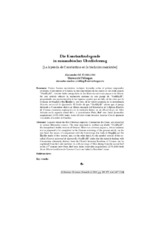Mostrar el registro sencillo del ítem
Die Konstantinslegende in mozarabischer Überlieferung
| dc.contributor.author | Schilling, Alexander M. | es_ES |
| dc.date.accessioned | 2012-01-31T10:57:36Z | |
| dc.date.available | 2012-01-31T10:57:36Z | |
| dc.date.issued | 2009 | |
| dc.identifier.issn | 1697-2104 | |
| dc.identifier.uri | http://hdl.handle.net/10396/6382 | |
| dc.description.abstract | Varias fuentes mozárabes incluyen leyendas sobre el primer emperador cristiano, Constantino el Grande, la más importante de las cuales es sin duda alguna “Hurusiyus”, versión árabe interpolada de las Historiae adversus paganos de Orosio. En este artículo ofrezco la traducción alemana de este pasaje de “Hurusiyus”, proponiendo una reconstrucción de las lagunas a partir, por un lado, de las citas que de él hacen al-Maqrizi e Ibn Haldun y, por otro, de la versión paralela de la denominada Historia universal de Qayrawan. El hecho de que “Hurusiyus” afirme que el pasaje dedicado a Constantino deriva en última instancia del historiador de la Iglesia Eusebio de Cesarea encuentra explicación en la tradición latina: en un Martirologio de Silos fechado en la segunda mitad del s. X (actualmente Paris, BnF mss. latins [nouvelles acquisitions] 2178-2180) tanto Actus Silvestri como Inventio Sanctae Crucis aparecen vinculados al nombre de Eusebio. | es_ES |
| dc.description.abstract | Legends about the first Christian emperor, Constantine the Great, are preserved in various Mozarabic sources. The most important is, without any doubt, “Hurusiyus”, the interpolated Arabic version of Orosius’ Historiae adversus paganos, whose lacunous text is proposed to be completed in the German rendering of the present article, on the one hand, by means of comparison with the borrowings that both al-Maqrizi and Ibn Haldun made of this section, and, on the other hand, by the parallel version of the socalled Historia universal de Qayrawan. Hurusiyus’ claim that the material dealing with Constantine ultimately derives from the Church historian Eusebius of Cesarea can be explained from the Latin tradition: in a Martyrology of Silos dating from the second half ot the 10th century (now Paris, BnF mss. latins [nouvelles acquisitions] 2178-2180) both Actus Silvestri and Inventio Sanctae Crucis are linked to Eusebius’ name. | es_ES |
| dc.format.mimetype | application/pdf | es_ES |
| dc.language.iso | deu | es_ES |
| dc.publisher | Universidad de Córdoba, Servicio de Publicaciones | es_ES |
| dc.rights | https://creativecommons.org/licenses/by/3.0/ | es_ES |
| dc.source | Collectanea Christiana Orientalia 6, 339-373 (2009) | es_ES |
| dc.subject | Orosio | es_ES |
| dc.subject | Traducciones árabes | es_ES |
| dc.subject | Constantino el Grande | es_ES |
| dc.subject | Orosius | es_ES |
| dc.subject | Arabic translations | es_ES |
| dc.subject | Constantine the Great | es_ES |
| dc.title | Die Konstantinslegende in mozarabischer Überlieferung | es_ES |
| dc.title.alternative | La leyenda de Constantino en la tradición mozárabe | es_ES |
| dc.type | info:eu-repo/semantics/article | es_ES |
| dc.relation.publisherversion | http://www.uco.es/servicios/publicaciones/revistas/index.php/cco/index | es_ES |
| dc.rights.accessRights | info:eu-repo/semantics/openAccess | es_ES |

